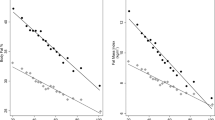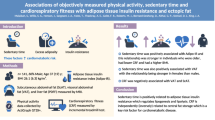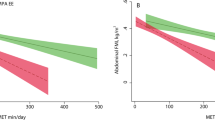Abstract
Background:
Differences in energy metabolism and physical activity (PA) may contribute to the long-term regulation of body weight (BW).
Objective:
To examine the associations between metabolic determinants, energy expenditure and objectively measured components of PA with change in BW and fat mass (FM).
Design:
Prospective (4 years.), case–control study in obese (n=13) and normal weight (n=15) young adults.
Measurements:
At baseline, we measured resting metabolic rate, substrate oxidation, movement economy (ml O2 kg−1 min−1), aerobic fitness (VO2max), total and PA energy expenditure by doubly labelled water, and PA by accelerometry. Fat mass was measured by DXA. At follow-up we repeated our measurements of PA and FM.
Results:
Fat mass increased significantly (P<0.001) in both groups. Physical activity did not change between baseline and ‘follow up’. Change in overall PA (counts per minute) was inversely associated with change in BW and (β=−0.0124, P=0.054) and FM (β=−0.008, P=0.04). Post hoc analyses suggested that this association was explained by changes in the normal weight group only (β=−0.01; P=0.008; and β=−0.0097; P=0.009, for BW and FM, respectively). Metabolic determinants, energy expenditure estimates and subcomponents of PA (i.e. time spent at different intensity levels) were not significantly associated with change in BW or FM.
Conclusion:
Our results suggest an independent association between PA and FM. However, this association may differ depending on obesity status. The gain in FM, without any change in PA, may suggest that dietary intake is the major contributor to the positive energy balance.
This is a preview of subscription content, access via your institution
Access options
Subscribe to this journal
Receive 12 print issues and online access
$259.00 per year
only $21.58 per issue
Buy this article
- Purchase on Springer Link
- Instant access to full article PDF
Prices may be subject to local taxes which are calculated during checkout



Similar content being viewed by others
References
Lobstein TJ, James WP, Cole TJ . Increasing levels of excess weight among children in England. Int J Obes Relat Metab Disord 2003; 27: 1136–1138.
Freedman DS, Srinivasan SR, Valdez RA, Williamson DF, Berenson GS . Secular increases in relative weight and adiposity among children over two decades: the Bogalusa Heart Study. Pediatrics 1997; 99: 420–426.
Moreno LA, Sarria A, Fleta J, Rodriguez G, Bueno M . Trends in body mass index and overweight prevalence among children and adolescents in the region of Aragon (Spain) from 1985 to 1995. Int J Obes Relat Metab Disord 2000; 24: 925–931.
Booth ML, Chey T, Wake M, Norton K, Hesketh K, Dollman J et al. Change in the prevalence of overweight and obesity among young Australians, 1969–1997. Am J Clin Nutr 2003; 77: 29–36.
Baskin ML, Ard J, Franklin F, Allison DB . Prevalence of obesity in the United States. Obes Rev 2005; 6: 5–7.
Rennie KL, Jebb SA . Prevalence of obesity in Great Britain. Obes Rev 2005; 6: 11–12.
Filozof C, Gonzalez C, Sereday M, Mazza C, Braguinsky J . Obesity prevalence and trends in Latin-American countries. Obes Rev 2001; 2: 99–106.
World Health Organization. Obesity – Preventing and Managing the Global Epidemic. World Health Organization: Geneva, 1998, pp 17–40.
Barsh GS, Farooqi S, O'Rahilly S . Genetics of body weight regulation. Nature 2000; 404: 644–651.
Bell CG, Walley AJ, Froguel P . The genetics of human obesity. Nat Rev Genet 2005; 6: 221–234.
Jéquir E, Tappy L . Regulation of body weight in humans. Physiol Rev 1999; 79: 451–480.
Hill JO, Peters JC . Environmental contributions to the obesity epidemic. Science 1998; 280: 1371–1374.
Koplan JP, Dietz WH . Caloric imbalance and public health policy. JAMA 1999; 282: 1579–1581.
Wareham NJ, van Sluijs EMF, Ekelund U . Physical activity and obesity prevention: a review of the current evidence. Proc Nutr Soc 2005; 64: 229–247.
Johnson MS, Figueroa-Colon R, Herd SL, Fields DA, Sun M, Hunter GR et al. Aerobic fitness, not energy expenditure, influences subsequent increase in adiposity in black and white children. Pediatrics 2000; 106: E50.
Figueroa-Colon R, Arani RB, Goran MI, Weinsier RL . Paternal body fat is a longitudinal predictor of changes in body fat in premenarcheal girls. Am J Clin Nutr 2000; 71: 829–834.
Salbe AD, Weyer C, Harper I, Lindsay RS, Ravussin E, Tataranni PA . Assessing risk factors for obesity between childhood and adolescence: II. Energy metabolism and physical activity. Pediatrics 2002; 110: 307–314.
Treuth MS, Butte NF, Sorkin JD . Predictors of body fat gain in nonobese girls with a familial predisposition to obesity. Am J Clin Nutr 2003; 78: 1212–1218.
Tataranni PA, Harper IT, Snitker S, Del Parigi A, Vozarova B, Bunt J et al. Body weight gain in free-living Pima Indians: effect of energy intake vs expenditure. Int J Obes Relat Metab Disord 2003; 27: 1578–1583.
Ekelund U, Brage S, Franks PW, Hennings S, Emms S, Wong MY et al. Physical activity energy expenditure predicts change in body composition in healthy Caucasians: effect modification by age. Am J Clin Nutr 2005; 81: 964–969.
Tremblay A, Simoneau JA, Bouchard C . Impact of exercise intensity on body fatness and skeletal muscle metabolism. Metabolism 1994; 43: 814–818.
Yoshioka M, Doucet E, St-Pierre S, Almeras N, Richard D, Labrie A et al. Impact of high-intensity exercise on energy expenditure, lipid oxidation and body fatness. Int J Obes Relat Metab Disord 2001; 25: 332–339.
Grediagin A, Cody M, Rupp J, Bernardot D, Shern R . Exercise intensity does not effect body composition change in untrained, moderately overfat women. J Am Diet Assoc 1995; 95: 661–665.
LeMura LM, Mazeikas MT . Factors that alter body fat, body mass, and fat-free mass in pediatric obesity. Med Sci Sports Exerc 2002; 34: 487–496.
Ekelund U, Åman J, Yngve A, Renman C, Westerterp K, Sjöström M . Physical activity but not energy expenditure is reduced in obese adolescents: a case–control study. Am J Clin Nutr 2002; 76: 935–941.
Ekelund U, Franks PW, Wareham NJ, Åman J . Oxygen uptakes adjusted for body composition in normal-weight and obese adolescents. Obes Res 2004; 12: 513–520.
De V, Weir JB . New methods for calculating metabolic rate with special reference to protein metabolism. J Physiol 1949; 109: 1–9.
Westerterp KR, Wouters L, Van Marken Lichtenbelt VD . The Maastricht protocol for the measurement of body composition and energy expenditure with labeled water. Obes Res 1995; 3 (Suppl 1): 49–57.
Black AE, Prentice AM, Coward WA . Use of food quotients to predict respiratory quotients for the doubly labeled water method of measuring energy expenditure. Hum Nutr Clin Nutr 1986; 40: 381–391.
Becker W, Lennernäs M, Gustavsson I-B, Haraldsdottir J, Nydahl M, Vessby B et al. Precoded food records compared with weighed food records for measuring dietary habits in a population of Swedish adults. Scand J Nutr 1998; 42: 145–149.
Maffeis C, Schutz Y, Zoccante L, Micciolo L, Pinelli L . Meal-induced thermogenesis in lean and obese prepubertal children. Am J Clin Nutr 1993; 57: 481–485.
Freedson PS, Melanson E, Sirard J . Calibration of the Computer Science and Applications, Inc. accelerometer. Med Sci Sports Exerc 1998; 30: 777–781.
Frayn KF . Calculation of substrate oxidation rates in vivo from gaseous exchange. J Appl Physiol 1983; 55: 628–634.
Van Itallie TB, Yang M-U, Heymsfield SB, Funk RC, Boileau RA . Height-normalized indices of the body's fat-free mass and fat-mass: potential useful indicators of nutritional status. Am J Clin Nutr 1990; 52: 953–959.
Wells JC . A critique of the expression of pediatric body composition data. Arch Dis Child 2001; 85: 67–72.
Ekelund U, Sjöström M, Yngve A, Poortvliet E, Nilsson A, Froberg K et al. Physical activity assessed by activity monitor and doubly labeled water in children. Med Sci Exerc Sports 2001; 33: 275–281.
Ekelund U, Åman J, Westerterp K . Is the ArteACC index a valid indicator of free-living physical activity in adolescents? Obes Res 2003; 11: 793–801.
Wareham NJ, Wong MY, Day NE . Glucose intolerance and physical inactivity: the relative importance of low habitual energy expenditure and cardiorespiratory fitness. Am J Epidemiol 2000; 152: 132–139.
Levine JA, Lanningham-Foster LM, McCrady SK, Krizan AC, Olson LR, Kane PH et al. Interindividual variation in posture allocation: possible role in human obesity. Science 2005; 307: 584–586.
Joosen AMCP, Geilen M, Vlietinck R, Westerterp K . Genetic analysis of physical activity in twins. Am J Clin Nutr 2005; 82: 1253–1259.
Petersen L, Schnohr P, Sörensen TI . Longitudinal study of the long-term relation between physical activity and obesity in adults. Int J Obes Relat Metab Disord 2004; 28: 105–112.
Ekelund U, Yngve A, Brage S, Westerterp K, Sjöström M . Body movement and physical activity energy expenditure in children and adolescents: how to adjust for differences in body size and age. Am J Clin Nutr 2004; 79: 851–856.
Ravussin E, Bogardus C . Energy balance and weight regulation. Br J Nutr 2000; 83 (Suppl 1): S17–S20.
Acknowledgements
We thank Bosse Arvidsson for DXA measurements in Örebro, and the staff at the Clinical Physiology Department, Örebro Medical Center for assistance during the study. We are also very grateful to the subjects and their families who gave their time to the study. This study was supported by grants from the Örebro County Council and the Swedish National Center for Research in Sports.
Author information
Authors and Affiliations
Corresponding author
Rights and permissions
About this article
Cite this article
Ekelund, U., Särnblad, S., Brage, S. et al. Does physical activity equally predict gain in fat mass among obese and nonobese young adults?. Int J Obes 31, 65–71 (2007). https://doi.org/10.1038/sj.ijo.0803361
Received:
Revised:
Accepted:
Published:
Issue Date:
DOI: https://doi.org/10.1038/sj.ijo.0803361
Keywords
This article is cited by
-
Relative contribution of energy intake and energy expenditure to childhood obesity: a review of the literature and directions for future research
International Journal of Obesity (2011)
-
Physical Activity Energy Expenditure of Adolescents in India
Obesity (2010)
-
Obesity in Irish youth: epidemiology and implications
Irish Journal of Medical Science (2009)



